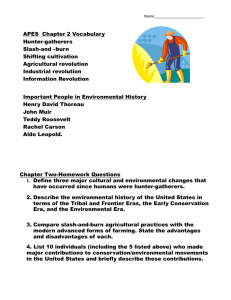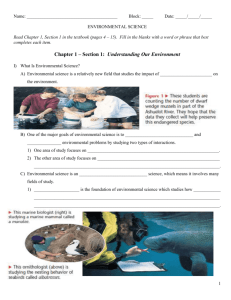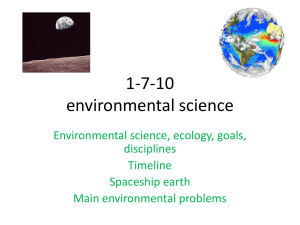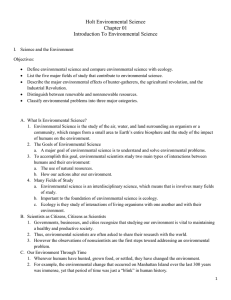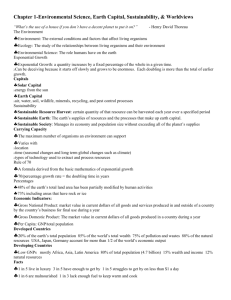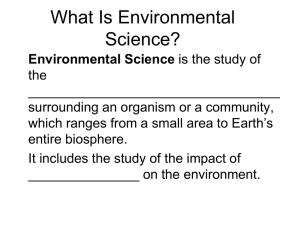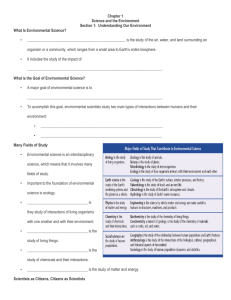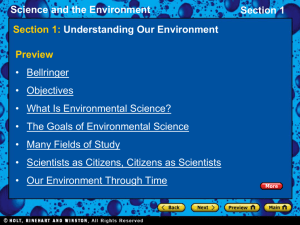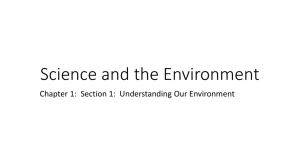Environmental Science
advertisement
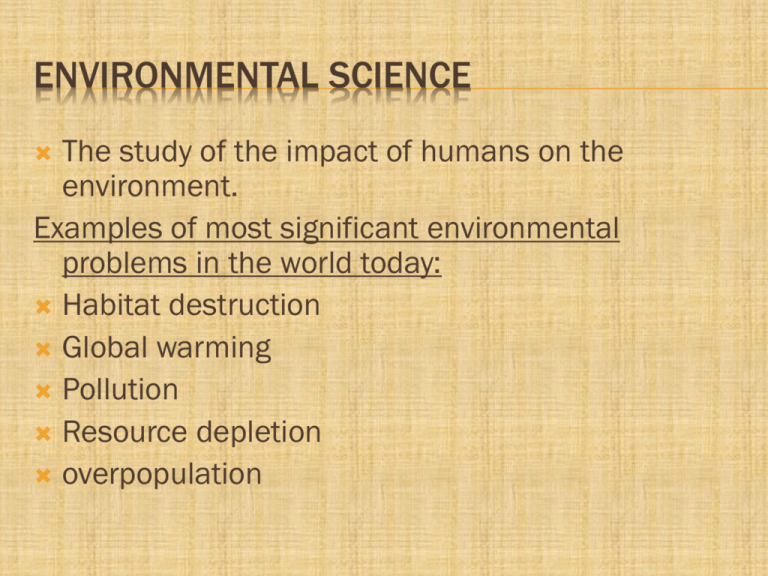
ENVIRONMENTAL SCIENCE The study of the impact of humans on the environment. Examples of most significant environmental problems in the world today: Habitat destruction Global warming Pollution Resource depletion overpopulation GOALS OF ENVIRONMENTAL SCIENCE Understand and solve environmental problems - how we use natural resources Ex. water, plants - how our actions alter the environment Ex. Habitat destruction, pollution FIELDS OF STUDY Interdisciplinary – involves many fields of study Ecology – the study of how living things interact with each other and with the non-living environment. Ex. Animal behavior Chemistry – pollutants Geology – how materials travel through earth FIELDS OF STUDY, CONT’D Botany, Zoology – preservation of species Earth sciences – hydrology,geology, climatology, palentology Physics-engineering, ex. Landscape, petroleum SCIENTISTS AS CITIZENS Studying the environment is vital to maintaining a healthy and productive society Scientists share research with the world through publications and conferences SCIENTISTS AS CITIZENS CITIZENS AS SCIENTISTS Citizens have an obligation to make observations of their surroundings and report changes that could affect a species or society as a whole Ex. Appearance of new species Ex. Disappearance of a species Ex. Change in habitat or species Ex. Water quality MAN’S EFFECT ON THE ENVIRONMENT THROUGH TIME Wherever humans have hunted, grown food, or settled, they have changed the environment I. Hunter-Gatherers A. over-hunting of a species (bison) B. burning prairies to prevent tree growth C. Combination of climate change and over hunting by huntergatherers led to loss of species including giant sloths, giant bison, mastodons, cave bears, and saber-toothed cats HUNTER-GATHERERS MAN’S EFFECT ON THE ENVIRONMENT THROUGH TIME CONT’D II. The Agricultural Revolution a. agriculture – the practice of growing, breeding, and caring for plants and animals that are used for food, clothing, housing, transportation, and other purposes. B. The dramatic impact of this change on human societies and their ennvrironment is called the agricultural revolution C. Effect: exponential human population growth, populations concentrated in smaller areas. MAN’S EFFECT ON THE ENVIRONMENT THROUGH TIME CONT’S Agricultural Revolution D. Domesticated plants we eat today are very different from wild ancestors E. Habitats destroyed to make farm land (slash and burn) MAN’S EFFECT ON THE ENVIRONMENT THROUGH TIME CONT’D III. Industrial Revolution A. B. C. D. A shift from energy sources such as animal muscle and running water to fossil fuels Greatly increased the efficiency of agriculture, industry, and transportation Large-scale production of goods mass produced in factories became less expensive Machinery reduced the amount of land and human labor needed for farming III. INDUSTRIAL REVOLUTION CONT’D E. Populations in urban areas steadily grew F. Motorized vehicles allowed food and other goods to be transported cheaply across great distances. G. Inventions and technology (light bulb, traffic light, cooling car, telephone) flourished and improved. H. sanitation, nutrition, medical care improved I. Negative consequences: Environmental problems resulting from the use of artificial substances such as plastics and other non-biodegradable items as well as pollution III. INDUSTRIAL REVOLUTION CONT’D SPACESHIP EARTH Earth is a closed system – the only thing that enters earth’s atmosphere in large amounts is energy from the sun, the only thing that leaves is heat. No new matter enters or leaves Earth’s systms. Resources used up quickly Waste produced more quickly than it can be disposed of Environmental problems are local (landfill), regional(oil spill), or global (ozone depletion) MAIN ENVIRONMENTAL PROBLEMS I. Resource depletion – a. natural resource – any natural material that is used by humans b. renewable resource – can be replaced within a lifetime c. nonrenewable resource – forms at a slower rate than it is being consumed D. resources are said to be depleted when a large fraction of a resource has been used up. EX. Renewable depleted resource – trees, water Nonrenewable depleted resource – copper mine MAIN ENVIRONMENTAL PROBLEMS CONT’D II. Pollution A. main effect of Industrial revolution – waste produced faster than it is disposed of. B. pollution – an undesired change in air, water, or soil that adversely affects the health, survival, or activities of humans or other organisms. Types: Biodegradable – can be broken down by natural processes Ex. Human sewage, food wastes. Non-biodegradable – cannot be broken down by natural processes Ex. Mercury, lead, plastic POLLUTION MAIN ENVIRONMENTAL PROBLEMS CONT’D III.Loss of Biodiversity A. biodiversity – the number and variety of species that live in an area. benefits – food, genetic diversity, natural resources of medicines and other goods B. extinction – loss of a species. At the end of the Permian period, 95 million years ago, as much as 95 percent of all species lost. QUIZ (THEY ARE DUE 7 MIN. AFTER TARDY BELL Use your book to answer these questions in complete sentences: 1) Use a Venn Diagram to contrast the environmental effects of the hunter-gatherer stage and the Industrial Revolution 2) Explain how environmental problems can be local, regional or global and give one example of each not mentioned in notes or book. 3) Is water considered renewable or non-renewable? Support your answer. Ch.1 Sec.2 The Environment and Society I. “Tragedy of the Commons’ A. Essay describe conflict between short term interests of individuals and the long-term welfare of society. B. Someone or group has to take responsibility for maintaining a resource. If no one takes that responsibility, the resource can be overused and become depleted. Ch.1 Sec.2 The Environment and Society II. Economics and the Environment A. Supply and demand – the greater the demand for a limited supply of something, the more that thing is worth. Economics and the Environment B. Costs and benefits – balances the cost of the action against the benefits one expects from it. • • • The cost of environmental solutions can be high. Ex. Increase in taxes for clean water, recycling program, habitat restoration and preservation. Consumer choices: light bulbs, more expensive products that meet environmental regulations. Economics and the Environment C. Risk Assessment – involved in cost-benefit analysis. The cost of any action is the risk of an undesirable outcome. • The public does not always perceive the risk accurately. • Ex. Nuclear power III. Developed and developing countries • • classified by the United Nations Developed countries have higher average incomes, slower population growth, diverse industrial economies, and stronger social support systems Ex. U.S.A., Canada, Japan,countries of western Europe. • Developing countries – lower average incomes, simple and agricultural based economies,and rapid population growth • Each (see pg.19) has different consumption patterns III. Population and Consumption In some areas, human population is growing too quickly for the local environment to support it When population grows too quickly there may not be enough natural resources for everyone in the area to live a healthy productive life. Developed countries use about 75% of world’s resources even though they make up only about 20% of the world’s population Economics and the Environment cont’d Ecological footprint – shows the productive area of Earth • needed to support one person in a particular country. Estimates the land used for crops, grazing, forest products, and housing, ocean for seafood, forest area needed to absorb the air pollution. Economics and the Environment Sustainability – the condition in which human needs are met in such a way that a human population can survive indefinitely. • • NOT happening now! Developed countries have higher standard of living because they are using resources faster than they can be replaced. What will your Impact on the Environment Be?
